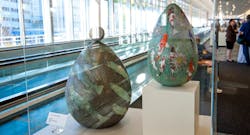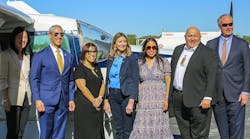A new era for the arts is about to begin at Minneapolis-St. Paul International Airport.
While art exhibits and performing arts have been a part of the passenger experience at MSP for many years, a new financing plan recently approved by the Metropolitan Airports Commission is designed to solidify the arts’ presence at the airport for years to come.
Starting in 2017, expenditures on public art at the airport will be tied to MSP’s capital improvements program and represent 1 percent of the program’s total for public facing projects in any given year. The new policy provides a stable funding mechanism. The actual amount spent on the arts from year to year may differ from funding amounts as monies are set aside in some years for major purchases in future years.
In a five-year plan submitted to the MAC’s Board of Commissioners recently, the annual amount dedicated to the arts varies depending on the capital budget that year and long-term plans for iconic purchases. But over the 2017 to 2021 time period, almost $5 million is expected to be spent on art at MSP International.
In the years ahead, the Percent for the Arts will fund iconic installations of artwork and pay for enhanced programs, according to Jana Webster, executive director of the MSP Airport Foundation, which administers the program. The plan for art enhancements includes more significant expenditures for commissioned art in 2019 and 2020, such as an “art park” and sculptures in Terminal 1.
“Our vision is to create memorable experiences for our passengers and showcase the talents of our region to the world,” Webster said.
The 1 percent figure for 2017 will total $3.66 million and provide a base for ongoing expenditures related to the arts. Art projects in that first year of the new program are expected to total $330,000, including an expanded musical performance program in Terminal 1 and Terminal 2, replacement of artwork at the Light Rail Transit entrance and rotating exhibits, to name a few.
The “Percent for the Arts” plan follows an amendment to the Arts and Culture master plan that the MAC created earlier this year. The new approach to funding will include an annual report on the five-year outlook for expenditures and its tie-in to the MAC’s capital improvement program.
Other enhancements could include additional performance pieces featuring dance, and continued rotating exhibits.
Examples of commissioned art already in the terminals includes the popular floor mosaics in both terminals -- such as the Nightlights mosaic in Terminal 2 -- and wall-sized mosaics designed by companies such as Mercury Mosaics of Minneapolis, which were recently installed in reconstructed bathrooms.



